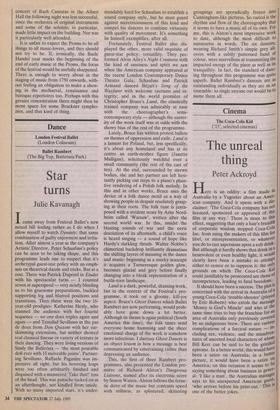Dance
Ballet Rambert (The Big Top, Battersea Park)
Star turns
Julie Kavanagh
Icame away from Festival Ballet's new mixed bill feeling rather as I do when I allow myself to watch Dynasty: that same combination of guilty enjoyment and irrita- tion. After almost a year as the company's Artistic Director, Peter Schaufuss's policy can be seen to be taking shape, and this programme leads one to suspect that it's archetypal guest-star policy with an emph- asis on theatrical dazzle and tricks. But at a cost. There was Patrick Dupond in Etudes with his spectacular turns — I counted seven at superspeed — very nearly blinding us to his gruesome preparations, buckled supporting leg and blurred positions and transitions. Then there were the two 16- year-old prodigies: Katherine Healy, who stunned the audience with her fouette sequence — no one does triples again and again — and Trinidad Sevillano in the pas de deux from Don Quixote with her ear- skimming extensions, but neither showed real classical finesse or variety of texture in their dancing. They were living versions of Sindy the Ballerina — 'the most poseable doll ever with 15 moveable joints'. Partner- ing Sevillano, Raffaele Paganini was im- pressive all right, but his hovering leaps were too often arbitrarily finished and disguised with a mannered 'Take that!' toss of the head. This was panache tacked on as an afterthought, not kindled from inside. With so many imported stars, it's under- standably hard for Schaufuss to establish a sound company style, but he must guard against meretriciousness of this kind and compel his dancers to combine virtuosity with quality of movement. It's something he himself exemplifies, after all.
Fortunately, Festival Ballet also dis- played the other, more valid requisite of guest-star policy: versatility. They per- formed Alvin Ailey's Night Creatures with the kind of sassiness and spirit we saw when the American company appeared at the recent London Contemporary Dance Theatre Gala; Schaufuss and Patrick Armand danced Bejart's Song of the Wayfarer with welcome tautness and in- tegrity; and in the world premiere of Christopher Bruce's Land, the classically trained company was admirably at ease with the choreographer's semi- contemporary style — although the auster- ity of the work itself was at odds with the showy bias of the rest of the programme.
Lately, Bruce has written protest ballets on themes of oppression and exile. Land is a lament for Poland, but, less specifically, it's about any homeland and has at its centre an earth-mother figure (Janette Mulligan), solicitously watchful over a small community (the rest of the cast of ten). At the end, surrounded by strewn bodies, she and her partner are left hesi- tantly picking out steps to a piano's plain- tive rendering of a Polish folk melody. In this and in other works, Bruce uses the device of a folk dance motif as a way of showing people in despair resolutely grasp- ing at their roots. The folk tune is juxta- posed with a strident score by Arne Nord- heim called 'Warsaw', written after the second world war. In this, amidst the blasting sounds of war and the eerie desolation of its aftermath, a child's voice is heard singing — a sound of hope like Hardy's darkling thrush. Walter Nobbe's chimerical backdrop brilliantly dramatises the shifting layers of meaning in the dance and music: beginning as a murky seascape it acquires a Turneresque golden glow, becomes glacial and grey before finally changing into a bleak representation of a battle-torn landscape.
Land is a dark, powerful, draining work, but in the context of the Festival's pro- gramme, it took on a gloomy, kill-joy aspect. Bruce's Ghost Dances which Ballet Rambert are now performing, would prob- ably have gone down a lot better. Although its theme is again political (South America this time), the folk tunes send everyone home humming and the sheer emotional charge of the work is somehow more infectious. I daresay Ghost Dances is an object lesson in how a message is best communicated by entertaining rather than depressing an audience.
This, the first of three Rambert pro- grammes, also presented the London pre- miere of Richard Alston's Dangerous Liaisons, named after its electronic score by Simon Waters. Alston follows the frene- tic drive of the music but contrasts speed with stillness, as splintered, skittering groupings are sporadically frozen into Cunningham-like pictures. So varied is the rhythm and flow of the choreography that it seems to have a music all of its own. For me, this is Alston's most impressive work to date, although the most difficult to suirunarise in words. The six dancers, wearing Richard Smith's simple grey all- overs with a subtly patterned band of colour, were marvellous at transmitting the impacted energy of the piece as well as its tranquillity. In fact, the standard of danc- ing throughout this programme was quite superb. Ballet Rambert's dancers are as outstanding individually as they are as an ensemble: to single anyone out would be to name them all.














































 Previous page
Previous page